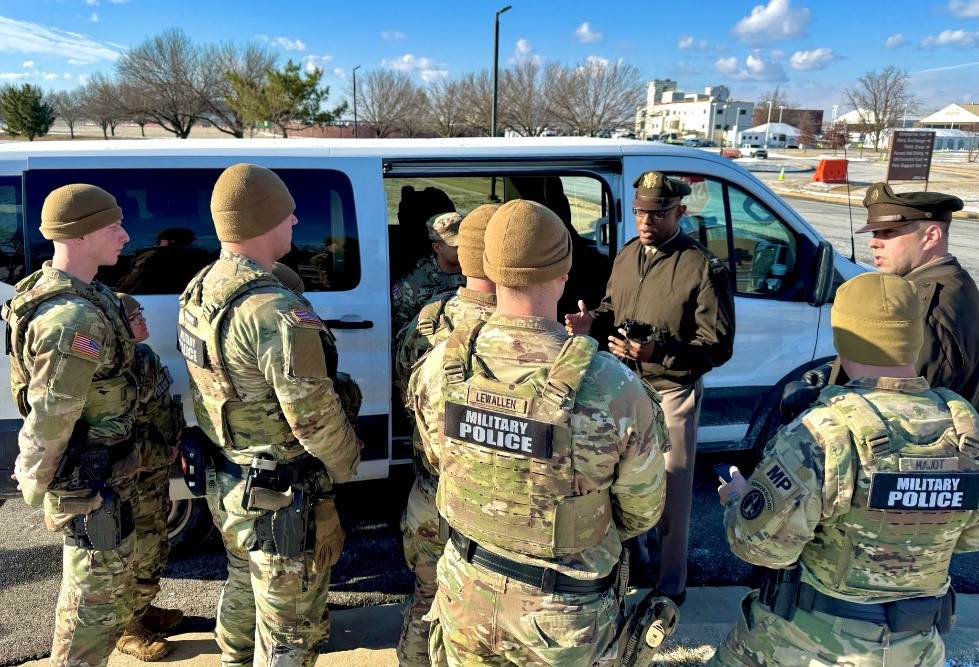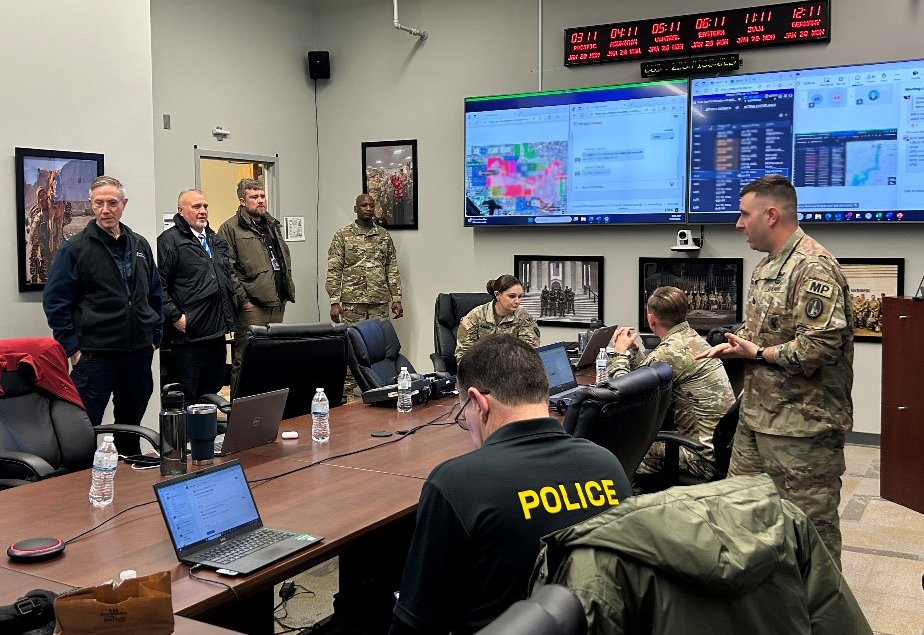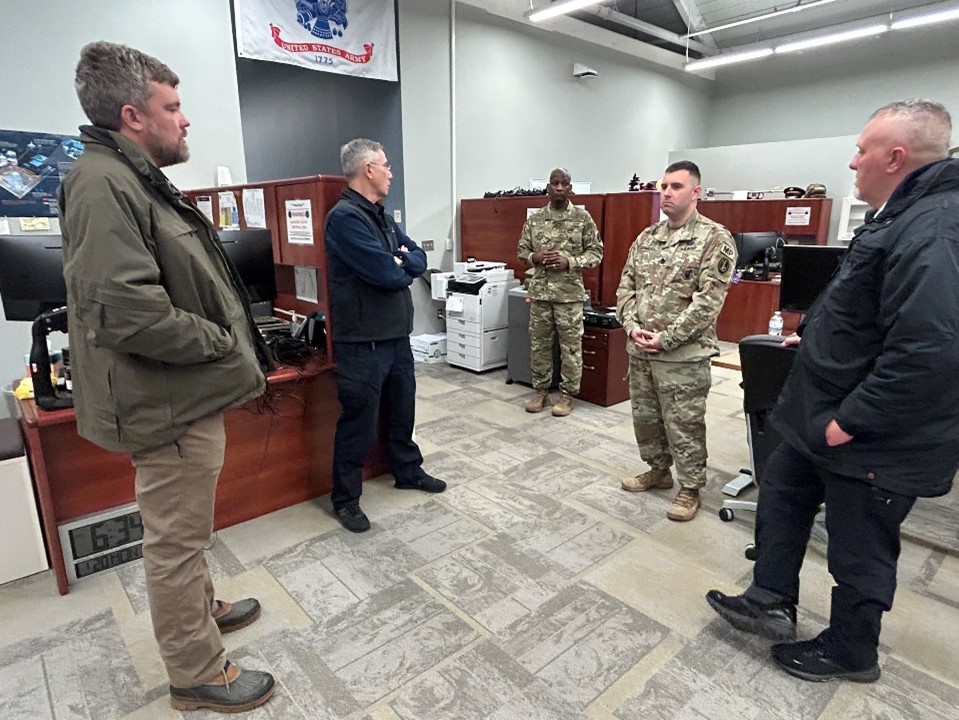Sergeant First Class Stephen J. Ricciardelli
Published 6/6/2025
The Joint Task Force–National Capital Region (JTF-NCR), together with emergency management professionals from the provost marshal office (PMO), faced a common challenge encountered by many military police units: they were unable to communicate with local U.S. Army military police through the provided radio networks. Additionally, there were significant concerns about whether the Directorate of Emergency Services (DES) could effectively communicate with its local, state, and federal partners. Over the next nine months, U.S. Army Colonel Mark R. Danner, provost marshal for the JTF-NCR and U.S. Army Military District of Washington (USAMDW), clearly defined the command’s mandate and led efforts to address this interagency communication issue.
The Challenge
The interoperability challenge faced by the JTF-NCR/USAMDW PMO goes beyond simple coordination issues. The NCR includes one joint base and three Army garrison installations, with the commanding general of JTF-NCR/USAMDW serving as the senior mission commander. This situation is further complicated by the fact that JTF-NCR is a standing joint task force under U.S. Northern Command, while the USAMDW reports directly to the Chief of Staff of the Army. Additionally, the DES at each Army installation is governed by the U.S. Army Installation Management Command in terms of equipment, systems, and policies. It is essential to navigate the complexities of individual command relationships within their respective component commands. Ensuring reliable communication between the task force and civilian agency partners during critical moments is crucial. Colonel Danner’s vision clearly outlined the goal: to achieve interoperability with all Department of Defense (DOD) and interagency partners in preparation for the upcoming presidential inauguration.
Investigating the Radio Communication Landscape
In August 2024, I conducted a thorough examination of the core issues surrounding radio communications. A significant concern that emerged was the lack of alignment between the land mobile radio networks and systems. It was discovered that, although the JTF-NCR operated a radio network utilized by various installations, the radios were acquired through different agreements, resulting in fragmented capabilities. Each organization primarily focused on its daily operations, which led to a variety of radio platforms and insufficient training and staffing to maintain the land mobile radio systems.
JTF-NCR encountered challenges due to the absence of a unified vision for coordinating emergency service systems across larger operations. Consequently, the team had to provide equipment on an event-by-event basis, often causing delays in critical actions as they managed the logistics of deploying resources.
The first step in addressing these issues was to analyze the preprogrammed radio frequencies assigned to each device. This analysis allowed the team to identify common frequencies among the radios, laying the foundation for creating a supplemental profile to enhance communication during events on JTF-NCR frequencies. Additionally, they established an emergency profile to improve collaboration between agencies.
Collaborating for Effective Interoperability
With a solid foundational understanding, PMO staff engaged with the Public Safety Communication Subcommittee of the Metropolitan Washington Council of Governments to explore their approach to interoperability. They shared valuable insights regarding the designated Region 20 code plug used throughout the joint operational area. (The Region 20 code plug refers to a configuration file used in digital mobile radio systems, specifically for public safety communications in Region 20.) The planning staff then loaded the appropriate frequencies onto the PMO radios in preparation for the upcoming inauguration.
The next critical step was to determine how the lead federal agency and key stakeholders allocated emergency frequencies according to the Incident Radio Communications Plan. Through collaborative efforts with the District of Columbia Fire Department, the planning team discovered that while the necessary frequencies were available on the radio, the JTF-NCR did not have the trunking keys required to access the repeaters designated for Unified Command during emergencies. Although secondary frequencies could assist in managing emergency support functions, a robust primary communication method was essential to bridge the gap between the DOD and Unified Command. To resolve this issue, the District of Columbia Fire Department provided radios for the Joint Law Enforcement Coordination Cell and the Joint Operations Center, establishing a crucial initial communication link between DOD and Unified Command support elements.
Ensuring Comprehensive Communication Solutions
Effective communication was crucial for the success of JTF-NCR PMO operations, which depended on multiple capabilities and systems. Voice communications using land mobile radios were part of a broader suite of devices designed to ensure the safety of both personnel and the public. However, the Army encountered challenges due to the absence of a cohesive solution for issues related to mobile data terminals and computer-aided dispatch. This highlighted the pressing need for reliable data communication and a common operating picture.
To address this need, a partnership was established with the First Responder Network Authority and its FirstNet® contract holder. This collaboration has provided a long-term evolution (LTE) solution and a common operating picture through Intrepid Networks.® FirstNet was created in response to the communication failures experienced during the 9/11 attacks, offering prioritized broadband LTE to support public safety and government operations. The network allows various departments to access restricted bandwidth, receive prioritization during critical events, utilize push-to-talk communication between land mobile radios and LTE, and deploy network assets to bolster national
special-security events.
Conclusion
In conclusion, overcoming the challenges of communication and interoperability within the NCR was crucial for enhancing the emergency response capabilities of JTF-NCR. By fostering collaboration, understanding the technical landscape, and implementing innovative solutions, we have laid a strong foundation for improved operational effectiveness and public safety in future efforts.
Endnote:
1“Incident Radio Communications Plan (ICS 205),” Federal Emergency Management Agency, <https://training.fema.gov/emiweb/is/icsresource/assets/ics%20forms/ics%20form%20205,%20incident%20radio%20communications%20plan%20(v3.1).pdf>, accessed on 15 May 2025.
Sergeant First Class Ricciardelli serves as a plans and operations noncommissioned officer for the JTF-NCR PMO. He holds a bachelor’s degree in criminal justice from the American Military University.







